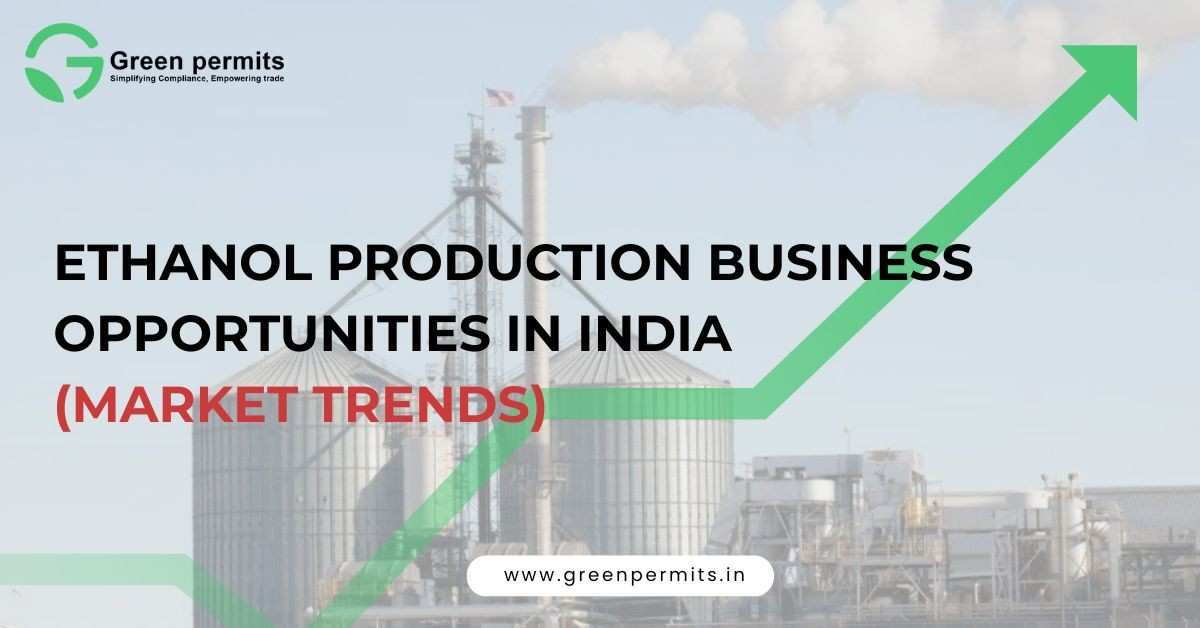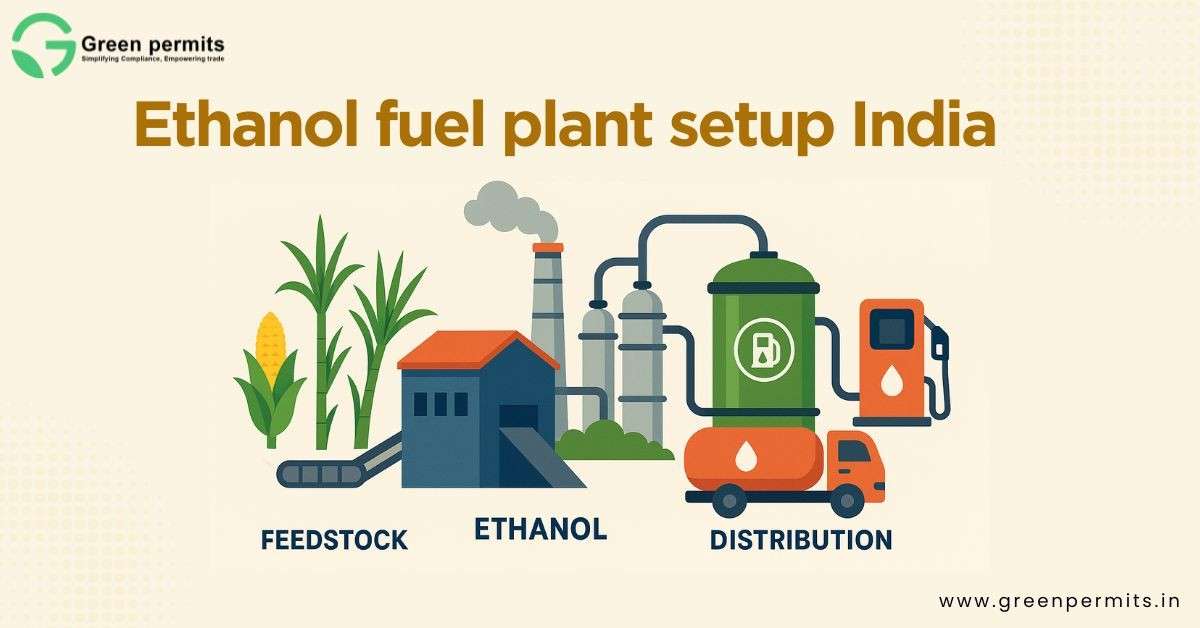India’s fuel economy is entering a transformative phase. With the E20 ethanol blending program (20% blending of ethanol with petrol by 2025), the government is pushing industries, farmers, and entrepreneurs toward a new energy future. For businesses, this is not just an environmental initiative — it’s a massive investment and revenue opportunity.
In 2023, India produced over 600 crore litres of ethanol, a 45% increase compared to 2022. The ethanol market, valued at USD 3 billion in 2024, is expected to cross USD 10 billion by 2033, growing at a CAGR of 14–16%. For entrepreneurs considering the ethanol business, the time is now.
Facts & Numbers Snapshot
The ethanol industry is backed by a strong policy push and rising demand:
- Ethanol blending achieved 15% in 2024, moving steadily toward 20% by 2025.
- India’s ethanol production capacity crossed 1,600 crore litres, projected to reach 1,700 crore litres by 2025.
- Over ₹41,000 crore loans were sanctioned in 2023–24 to support new distilleries and plant expansions.
- Ethanol blending saved ₹30,000+ crore in crude oil imports in 2023 alone.
- States like Uttar Pradesh, Bihar, and Maharashtra have emerged as ethanol hubs, with dozens of new projects cleared.
These numbers highlight not just a fuel substitution program but a profitable business ecosystem for those ready to invest.
Why Ethanol Business is a Golden Opportunity in India
The ethanol business is not limited to fuel alone. Ethanol has applications across pharmaceuticals, beverages, sanitizers, and chemicals, but its biggest driver in India is the Ethanol Blended Petrol (EBP) program. Oil Marketing Companies (OMCs) like IOCL, BPCL, and HPCL are mandated to procure ethanol from domestic distilleries at fixed remunerative prices, ensuring stable demand.
For distilleries, sugar mills, and grain processors, ethanol provides:
- Guaranteed market through OMC offtake contracts.
- Government subsidies such as interest subvention and viability gap funding.
- Diversification into a growing energy sector.
- Contribution to ESG goals — reducing carbon emissions and supporting farmer incomes.
Types of Ethanol Plants: Molasses vs Grain vs 2G
Not all ethanol plants are the same. Entrepreneurs must evaluate feedstock, costs, and technology before choosing their model.
Comparison Table: Molasses vs Grain vs 2G Ethanol Plants
| Feature | Molasses-Based | Grain-Based (Maize/Rice) | 2G (Crop Residue/Waste) |
|---|---|---|---|
| Feedstock | Byproduct of sugar mills | Maize, rice, broken rice, surplus grains | Crop residues, agri-waste, lignocellulose |
| Availability | High in sugar-producing states | Growing demand; supported by FCI, MSP | Still in pilot stage, limited suppliers |
| Water Use | Moderate | Lower than molasses | Variable, depends on technology |
| CapEx (₹ Cr/KLPD) | 10–15 | 15–20 | 20–25+ |
| Timeline | 12–18 months | 18–24 months | 24–36+ months |
| Approvals | SPCB, MoEFCC EC, Excise | SPCB, MoEFCC, Excise, Grain procurement | MoEFCC, SPCB, advanced R&D clearances |
| Subsidies | Interest subvention available | Strong support under grain ethanol policy | Biofuel R&D and VGF support emerging |
| Viability | Well-established, stable returns | Growing fast with OMC contracts | High potential, longer ROI |
Step-by-Step Guide to Setting Up an Ethanol Plant in India
Many entrepreneurs hesitate because of compliance complexity. But with the right roadmap, setting up an ethanol unit can be straightforward.
Step-by-Step Checklist
- Land & Business Incorporation
- Acquire industrial land in designated zones.
- Register your business entity (Private Ltd., LLP, or Partnership).
- Environmental Clearances
- MoEFCC: Obtain Environmental Clearance (EC) if project size meets thresholds.
- State Pollution Control Board (SPCB): Get Consent to Establish (CTE) and later Consent to Operate (CTO).
- Excise Licensing
- Apply for distillery license from the State Excise Department.
- Mandatory for both molasses and grain-based units.
- BIS Certification
- Ensure ethanol meets Bureau of Indian Standards (BIS) specifications for blending.
- CPCB/SPCB Approvals
- Register under applicable waste management rules (if byproducts generated).
- OMC Procurement Agreement
- Sign long-term supply contracts with IOCL, BPCL, or HPCL.
- Finance & Subsidies
- Apply for government Interest Subvention Scheme (6% p.a. or 50% of interest).
- Explore loans under priority sector lending.
- Plant Construction & Machinery Setup
- Install fermenters, distillation columns, boilers, effluent treatment (ZLD system).
- Trial & Commissioning
- Conduct trial runs, submit reports to SPCB and Excise.
- Full-Scale Operations
- Begin production, comply with reporting and monitoring requirements.
Case Study: Grain Mill to Ethanol Unit
A grain-processing mill in Uttar Pradesh converted part of its facility into a 60 KLPD ethanol plant.
- Investment: ₹150 Crore.
- Timeline: 20 months.
- Financing: Received government interest subvention (6% p.a. subsidy).
- Revenue Model: OMC contracts ensured steady cash flows.
- Payback Period: ~4 years.
This success story shows how traditional agro-industries can diversify profitably into ethanol.
ESG & Sustainability Benefits of Ethanol Plants
The ethanol business is not just about profits — it’s also about sustainability.
- Carbon Reduction: Every litre of ethanol blended reduces crude oil imports and lowers GHG emissions.
- Import Savings: India saved ₹30,000+ crore in crude oil imports in 2023 through ethanol blending.
- Circular Economy: Crop residues, surplus rice, and molasses are diverted from waste to value-added fuel.
- Water Efficiency: Grain ethanol plants often use less water compared to molasses distilleries.
- Farmer Support: Ethanol procurement boosts MSP for grains and ensures stable demand for sugarcane.
For corporates, ethanol plants also strengthen ESG scores, helping attract green financing and global investors.
FAQs on Ethanol Plant Business in India
India achieved 15% ethanol blending by 2024 and is targeting 20% (E20) by 2025.
Environmental Clearance (MoEFCC)
Consent to Establish/Operate (SPCB)
State Excise License
BIS certification for fuel-grade ethanol
OMC supply contracts
Molasses-based: ₹100–150 crore for 60 KLPD
Grain-based: ₹150–200 crore for 60 KLPD
2G (crop residue): ₹250+ crore, depending on technology
Yes. The government offers Interest Subvention (6% or 50% interest), priority sector lending, and support for Zero Liquid Discharge (ZLD) systems.
Molasses: 12–18 months
Grain: 18–24 months
2G: 24–36 months
With assured OMC offtake and subsidies, ethanol plants can achieve 12–18% IRR, with payback in 4–6 years.
Conclusion
The ethanol plant business in India is a once-in-a-generation opportunity. With government mandates, assured demand from OMCs, and financial incentives, businesses entering this space can expect strong returns while contributing to India’s green energy future.
At Green Permits, we simplify the compliance journey — from MoEFCC and CPCB approvals to Excise licensing and BIS certification. Whether you’re a sugar mill, grain processor, or new entrepreneur, we help you design, license, and commission your ethanol plant seamlessly.
📞 Call Us: +91-78350 06182
📧 Email: wecare@greenpermits.in
🌐 Visit: www.greenpermits.in
Book a Consultation for Ethanol Plant Setup today and step into India’s sustainable fuel future.









